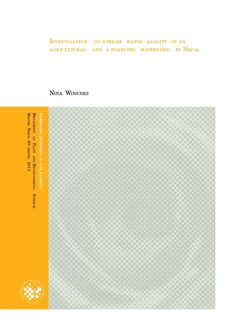Investigation of stream water quality in an agricultural and a forested watershed in Nepal
Master thesis
Permanent lenke
http://hdl.handle.net/11250/189593Utgivelsesdato
2014-02-17Metadata
Vis full innførselSamlinger
- Master's theses (IPM) [204]
Sammendrag
Nepal has long faced difficulties regarding population growth and food production, and
intensified agriculture with expansion to the steep hills has led to erosion, soil degradation
and water pollution; compromising both soil and water quality.
Two watersheds with different land use pattern in the Middle hills of Nepal are investigated
to assess the impact of land use differences. The study is based on stream water quality in
Mahadev Khola (MK), a water resource for Bhaktapur municipality, and Ghatte Khola (GK),
representing a forested and an agricultural watershed, respectively. The sampling was
conducted over 16 weeks, during monsoon and post monsoon, with the main objective to
investigate the agricultural impact on stream water quality compared to a forested
watershed, in light of seasonal variations.
Significantly higher Nitrogen‐concentration in GK compared to MK suggests chemical
fertilizers to interfere with the natural inputs in the watershed, resulting in increased
concentrations of total‐N in GK. Turbidity, with a significantly higher monsoonal mean of 21,
9 NTU and total‐N with a corresponding concentration of 1, 825 mg/l both appear to be a
direct result of agricultural land use. Both parameters are significantly higher also during
monsoon compared to post monsoon (p = 0, 000 for both parameters). Still, the use of level
terraces appears to some extent to prevent excessive erosion.
On the contrary, Phosphorus appears to be naturally occurring with high concentrations of P
in both streams; 1319 μg/l and 1089 μg/l in MK and GK, respectively. Stream pH of 7, 42 and
7, 56 in MK and GK respectively indicates together with no liming practices a neutral soil
with low retention of P. A low correlation coefficient between P and turbidity indicates P to
be in solution and available to crops, which may explain the farmers practice of application
of urea (Nitrogen fertilizer) rather than NKP. This suggests a system with a naturally
occurring bio available P‐source. The correlated fluctuations in MK and GK (R2 = 94, 1 %) also
during post monsoon indicates P to enter streams via runoff and a common hydro geological
pattern.
The high concentrations of P exceed the recommended limits for reservoirs and for streems
emptying into lakes and have potential to cause algal growth, however this was not reported
as a problem at the reservoir. Nepal har lenge stått ovenfor utfordringer relatert til befolkningsvekst og matproduksjon.
Intensifisert jordbruk med ekspandering til bratte dalsider har resultert i erosjon og tap av
næringsstoffer som påvirker både jord‐ og vannkvalitet. I tillegg bidrar utilstrekkelige
sanitetsforhold til mangel på rent drikkevann.
To nedbørsfelt med ulikt bruksmønster i Nepals Mid hills er undersøkt. Studiet er basert på
16 ukers måling av vannkvaliteten i elvene Mahadev Khola (MK) og Ghatte Khola (GK) (Khola
= liten elv), som representerer henholdsvis et skogsdominert og et jordbruksdominert
nedbørsfelt. MK er vannkilde for Bhaktapur municipality, og den eneste av overflateopphav.
Vannprøvetaking ble utført under monsoon og post monsoon, med hovedmål om å
undersøke hvordan ulikt bruksmønster, jordbruk og skog, påvirker vannkvaliteten i elvene i
lys av sesongvariasjoner.
Signifikant høyere nitrogen‐konsentrasjon i GK sammenlignet med MK antyder at kjemisk
mineralgjødsel påvirker det naturlige systemet, med resultat i høyere N‐konsentrasjon i GK.
Både turbiditet og N viser signifikant høyere gjennomsnittsverdier under monsoon
sammenlignet med post monsoon med verdier på henholdsvis 21, 9 NTU og 1, 825 mg/l, og
virker å være et direkte resultat av jordbruk i nedbørsfeltet. Begge parametre er også
signifikant høyere under monsoon sammenlignet med post monsoon innad i nedbørsfeltet
(p = 0, 000 for begge parametre). Likevel virker terrassejordbruket til en viss grad å forhindre
erosjon.
I motsetning til N virker P å være naturlig forekommende i begge nedbørsfelt og ikke et
resultat av ulik driftsform; med konsentrasjoner på 1319 μg/l og 1089 μg/l i henholdsvis MK
og GK. En pH i MK og GK på henholdsvis 7, 42 og 7, 56 indikerer, sammen med ingen
kalkingspraksis i jordbruket, en nøytral jord med lav retensjon av P. Korrelasjon mellom Pfluktasjoner
i MK og GK (R2 = 94, 1 %), også under post monsoon, indikerer at P tilføres
elvene både via avrenning og grunnvann. Lav korrelasjonskoeffisient mellom turbiditet og P
antyder P å være i løsning og dermed tilgjengelig for avlinger.
Den høye P‐konsentrasjonen overstiger anbefaling om P‐konsentrasjon i inntak til reservoar
og kan potensielt føre til algeoppblomstring både i vannreservoaret til MK, samt i roligere
vann nedstrøms, men dette var ikke rapportert.
